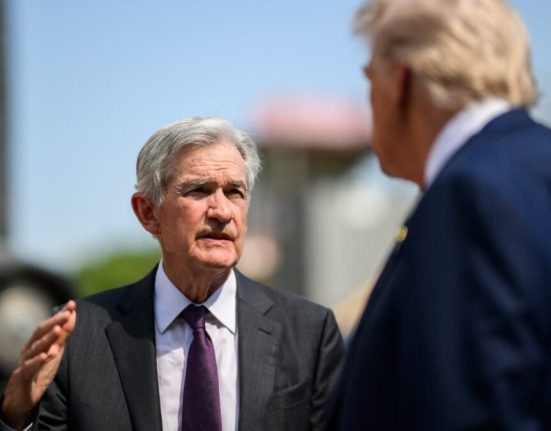A t-shirt reading ‘Bitcoin Be Your Own Bank’ inside a cryptocurrency exchange in Barcelona, Spain, … More
We’ve seen waves of big institutional players adopt Bitcoin – even traditionally conservative players. The talk of the town has been nation-state adoption of Bitcoin, from El Salvador’s experiment with Bitcoin as legal tender to recent actions in the United States with the new Administration. Yet pension funds are inching in as well.
A reflection of this has been the small but growing number of pension funds that are adopting Bitcoin – a unique phenomenon that marks a unique path in Bitcoin’s evolution that has remained understudied – for the moment. The state of Wisconsin’s pension fund has adopted Bitcoin through investment in spot Bitcoin ETFs. An unnamed UK pension scheme has made a 3% allocation to Bitcoin working with Cartwright. The State of Michigan Retirement System has made a multi-million dollar investment in Bitcoin ETFs. And while it’s small steps at the beginning, as more institutions gather Bitcoin, this is a promising path forward for adoption.
Much of the background research and points come out of a conversation with two sources who have vast experience with pension fund adoption – Sam Roberts of Cartwright, which has advised a UK-based pension fund to allocate 3% towards Bitcoin, and Dom Bei of Proof of Workforce which has helped various unions save holdings in Bitcoin.
Pension funds aren’t just a new player – they are a different type of player – marking a new evolution for Bitcoin as it matures into the gold standard for digital money.
1- Bitcoin, not crypto
For players in the space, especially pension funds, lasting time horizons are essential. They can’t just pull their funds out willy-nilly – they need to be invested in something for at least ten years – and sometimes longer. Pension funds see a difference between Bitcoin and other cryptocurrencies – a bias that will persist in both legal systems, in the eyes of nation-states, and institutional players with very long time horizons – such as sovereign wealth funds.
Pension funds see Bitcoin as the only option in a crowded field – with other cryptocurrencies going extinct fast compared to Bitcoin.
2- When evaluated properly, Bitcoin stands above all other assets
When pension funds evaluate Bitcoin, they must remember that it’s like any other asset out there – and that its risk/reward profile stands out to carry the day. As Sam from Cartwright points out, the trick is to get pension trustees to look beyond the polarizing debate and simply counsel to evaluate Bitcoin on its merits and the numbers. If you already believe in the staying power of Bitcoin, then once you take a look at the numbers, Bitcoin stands out as the best-performing financial asset of the last decade. Once you anchor to the math and escape the narrative, Bitcoin paradoxically looks better to institutional players like pension funds.
3- A small allocation is dipping toes into the pool
Right now, the winning formula for convincing pension funds is starting (and ending) with Bitcoin in a small percent of their allocation – say in the low single digits towards 1-3%. This smaller allocation allows pension funds not to worry about the short-term volatility of Bitcoin and look more towards the long-term horizon. Even a small allocation can produce outsize returns – enough to justify dipping in. This line of reasoning was part of the reason how Cartwright got a UK pension scheme to allocate 3% to Bitcoin.
4- The store of value is winning out, but the medium of exchange is being explored
While most pensions are interested in Bitcoin as a store of value (echoing what’s happening in cities and states around the world that want to hold Bitcoin on their reserves), small steps are being taken to explore Bitcoin’s use as a medium of exchange – for example, payroll services. While store of value is the more obvious case to push forward, it’s clear that there’s room for pension funds to experiment with Bitcoin beyond just holding it on their balance sheets – with experiments towards Bitcoin salaries among top Bitcoin companies.
5- Pension funds and unions of all kinds are joining the fun – though it’s very early
It’s not just regular pension funds – but also pension funds for blue-collar workers that are looking in. There is a broad appeal to saving beyond just general pension funds. Dom Bei has, for example, onboarded several firefighter unions to start investing in Bitcoin. This is a critical step forward even though it’s one thing to get a pension fund in and another to get a union. As he puts it: “Bitcoin adoption among U.S. pension funds remains low, with few holding it, while unions across public and private sectors increasingly add Bitcoin to their balance sheets. Despite their structural differences, unions and pension funds share a core ethos: advocating for workers’ present and future. Both should approach Bitcoin similarly—minimizing risk while learning about a tool born from a financial crisis that devastated workers. As a top 10 global asset by market cap, Bitcoin demands exploration by fund managers and union leaders as a network, financial tool, and store of value for wage-earners.”
—
Pension funds are traditionally seen as arch-conservative in their investment choices. The fact that a few are dipping their toes into Bitcoin (and Bitcoin only) is worth examining – tracing a new path for Bitcoin as it continues to march ahead of its crypto competitors.








